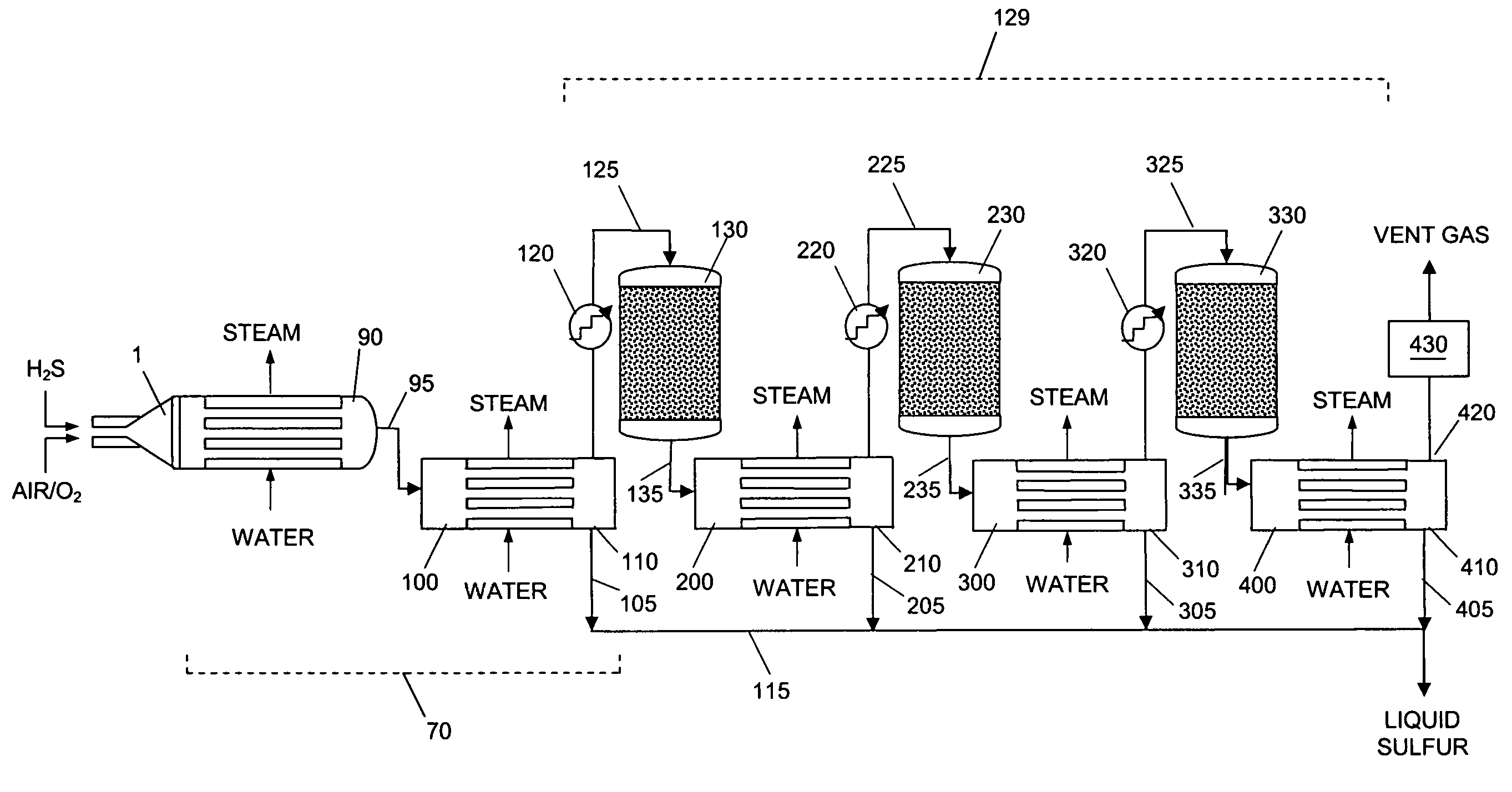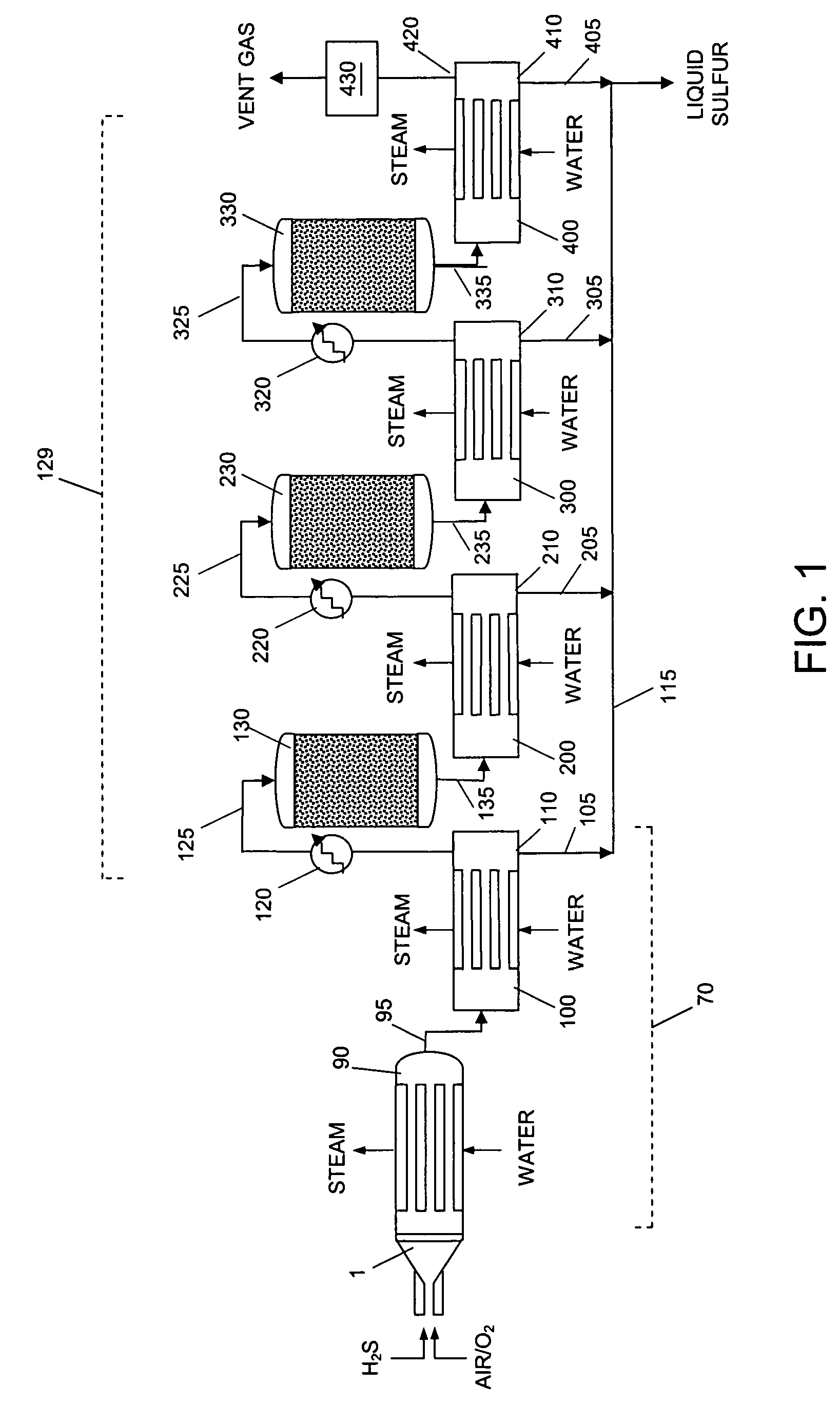Apparatus and catalytic partial oxidation process for recovering sulfur from an H2S-containing gas stream
a technology of partial oxidation and apparatus, which is applied in the direction of separation process, sulfur preparation/purification, lighting and heating apparatus, etc., can solve the problem that the conventional claus plant cannot handle such large amounts of hsub>2/sub>s, and achieve the effect of less costly sulfur recovery plant and process, short contact time and expansion of claus plant capacity
- Summary
- Abstract
- Description
- Claims
- Application Information
AI Technical Summary
Benefits of technology
Problems solved by technology
Method used
Image
Examples
example 1
SPOC™ Resolves the Problem of Hydrocarbon Contamination of the H2S Feed
[0062]The typical problems caused by hydrocarbon contamination of the H2S feed are greatly improved or entirely avoided by the present process. The standard Claus burner / combustion stage is improved upon by only partially oxidizing the hydrocarbon components of the H2S feed instead of fully combusting them. Full or complete combustion can be described by the reaction
CmHn+(m+n / 4)O2→mCO2+n / 2H2O (7)
whereas partial oxidation of a hydrocarbon can be described by the reaction
CmHn+(a+b / 2+d / 2)O2.aCO2+bCO+cH2+dH2O+(m−a−b)CmHn (8)
For partial oxidation, (a+b / 2+d / 2)<(m+n / 4).
[0063]The effect of including methane in the H2S feed was determined as follows: The laboratory scale SPOC™ reactions were carried out in a modified conventional flow apparatus using a quartz reactor with a length of 12 inches, an outside diameter of 19 mm and an inside diameter of 13 mm. Ceramic foam pieces of 99% Al2O3 (12 mm outside diameter×5 mm thi...
example 2
SPOC™ Resolves the Problem of Excessive CO2 in the H2S Feed
[0070]The test procedure described in Example 1 was employed, except methane was omitted from the H2S feed and CO2 was included in the amounts indicated in Table 3. The test data in Table 3 shows the conversions attained using the present invention with varying levels of CO2 in the feed, normally classified as “lean” feeds for a Claus plant. These reaction yields were attained with stable reaction conditions that did not include fuel gas addition or equipment to split the flow of H2S, in contrast to typical Claus processes in which excessive CO2 is present in the feed.
[0071]
TABLE 3Straight-through Conversion of Low Levels of H2S to Sulfur% H2S Flow% CO2 in Feed% Sulfur Yield33.7566.2567.028.9671.0466.225.3674.6466.622.5577.4566.7
example 3
SPOC™ Process Destroys Ammonia in the Feed
[0072]The same test procedure described in Example 1 was employed, except methane was omitted from the H2S feed and NH3 was included in the amount indicated in Table 4. The catalyst was composed of 2% Pt-1% Rh / 2% Mg on magnesium oxide granules, and formed a ¾″ L×½″ D bed. The test results in Table 4 show the NH3 destruction performance under the indicated conditions. It can also be appreciated that the SPOC™-modified Claus process provides an advantage over conventional Claus processes in reduced residence time.
[0073]
TABLE 4Inlet NH3NH3concentrationResidenceconversionAirH2SNH3Air / (%)Time (msec)(%)(SLPM)(SLPM)(SLPM)(H2S + NH3)H2S / NH314.10738.483.322.6520.9620.1582.376.114.10737.387.692.7630.9620.1582.476.114.12036.393.922.8730.9610.1582.576.114.12035.397.632.9860.9610.1582.676.114.12034.497.973.0950.9610.1582.776.114.10733.598.693.2060.9620.1582.866.114.12032.698.823.3190.9610.1582.976.1
[0074]As demonstrated above, a preferred SPOC™ catalyst ...
PUM
| Property | Measurement | Unit |
|---|---|---|
| temperature | aaaaa | aaaaa |
| contact time | aaaaa | aaaaa |
| contact time | aaaaa | aaaaa |
Abstract
Description
Claims
Application Information
 Login to View More
Login to View More - R&D
- Intellectual Property
- Life Sciences
- Materials
- Tech Scout
- Unparalleled Data Quality
- Higher Quality Content
- 60% Fewer Hallucinations
Browse by: Latest US Patents, China's latest patents, Technical Efficacy Thesaurus, Application Domain, Technology Topic, Popular Technical Reports.
© 2025 PatSnap. All rights reserved.Legal|Privacy policy|Modern Slavery Act Transparency Statement|Sitemap|About US| Contact US: help@patsnap.com



